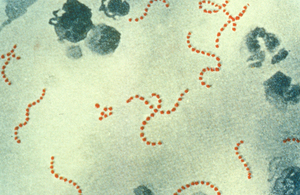Scarlet fever: second year of high activity
Latest PHE report shows high number of scarlet fever notifications across England, with 5746 reported cases since September 2014.

scarlet fever pathogen
Public Health England (PHE) has reported a continued substantial increase in scarlet fever notifications across England. This is the second year in a row of exceptional activity. A total of 754 new cases were reported in England last week (2 to 8 March) and 5746 since the season began in September (week 37 in 2014 to week 10 2015). This compares to 2833 cases for the same period last season.
Dr Theresa Lamagni, PHE’s head of streptococcal infection surveillance, said:
We’re continuing to see a considerable increase in the number of people diagnosed with scarlet fever across England confirming this is the second season in a row with exceptionally high numbers. Scarlet fever is a seasonal disease and this is the time of year when the highest numbers of cases are typically seen.
Given that the scarlet fever season should peak within the next few weeks, we should see a reduction in numbers soon, but in the meantime substantial numbers of people will continue to be affected. Historically, seasons of high incidence have been preceded by seasons of intermediate incidence and it remains possible that we will exceed last year’s exceptional high level of activity. The reasons behind this increase are unclear but may reflect long-term natural cycles in disease incidence. Close monitoring, rapid and decisive response to potential outbreaks and early treatment of scarlet fever with antibiotics remains essential, especially given the potential complications associated with group A streptococcal infections.
Parents can play a key role in recognising when their child needs to be seen by their GP. Early signs to look out for are sore throat, headache and fever with the characteristic pinkish sandpapery rash appearing within a day or two, typically on the chest and stomach but then spreading to other parts of the body. Individuals who think they or their child may have scarlet fever should see their GP without delay as antibiotic treatment is needed. Symptoms usually clear up after a week and in the majority of cases remain reasonably mild providing a course of antibiotics is completed to reduce the risk of complications. As scarlet fever is highly contagious, children or adults diagnosed with scarlet fever are advised to stay at home until at least 24 hours after the start of antibiotic treatment to avoid passing on the infection.
GPs as well as schools and nurseries should be mindful of the current high levels of scarlet fever and promptly inform local health protection teams if they become aware of cases, especially if more than one child is affected. PHE strongly urge schools to embed good hand hygiene practices within daily routines for pupils and staff. Children and adults should be encouraged to cover their mouth and nose with a tissue when they cough and sneeze and to wash their hands after using or disposing of tissues.
Scarlet fever is mainly a childhood disease and is most common between the ages of 2 and 8 years. It was once a very dangerous infection, but although much less serious now, complications can arise, particularly in those who remain untreated. There is currently no vaccine for scarlet fever.
Background
Scarlet Fever notifications and rate per 100,000 population by PHE Centre in 2013 to 20114 and 2014 to 2015 (weeks 37 to 10)
| PHE Centre | 2013 to 2014 season: weeks 37 to 10 - number of cases | 2013 to 2014 season: weeks 37 to 10 - rate | 2014 to 2015 season: weeks 37 to 10 - number of cases | 2014 to 2015 season: weeks 37 to 10 - rate | Rate ratio |
|---|---|---|---|---|---|
| Anglia and Essex | 154 | 3.7 | 269 | 6.4 | 1.7 |
| Avon, Gloucestershire and Wiltshire | 211 | 8.8 | 284 | 11.9 | 1.3 |
| Cheshire and Merseyside | 118 | 4.9 | 364 | 15 | 3.1 |
| Cumbria and Lancashire | 116 | 5.9 | 259 | 13.2 | 2.2 |
| Devon, Cornwall and Somerset | 105 | 4.7 | 156 | 7 | 1.5 |
| East Midlands | 337 | 8.7 | 619 | 15.9 | 1 |
| Greater Manchester | 181 | 6.7 | 309 | 11.4 | 1.7 |
| Kent, Surrey and Sussex | 183 | 4 | 421 | 9.3 | 2.3 |
| London | 278 | 3.3 | 532 | 6.3 | 1.9 |
| North East | 217 | 8.3 | 376 | 14.4 | 1.7 |
| South Midlands and Hertfordshire | 168 | 6.4 | 274 | 10.4 | 1.6 |
| Thames Valley | 158 | 7.7 | 260 | 12.6 | 1 |
| Wessex | 119 | 4.4 | 302 | 11.3 | 2.5 |
| West Midlands | 170 | 3 | 485 | 8.5 | 2.9 |
| Yorkshire and the Humber | 315 | 5.9 | 836 | 15.7 | 2.7 |
| England | 2830 | 5.3 | 5746 | 10.7 | 2 |
Read the latest health protection report.
Further information on scarlet fever.
Public Health England’s mission is to protect and improve the nation’s health and to address inequalities through working with national and local government, the NHS, industry and the voluntary and community sector. PHE is an operationally autonomous executive agency of the Department of Health. www.gov.uk/phe Follow us on Twitter @PHE_uk